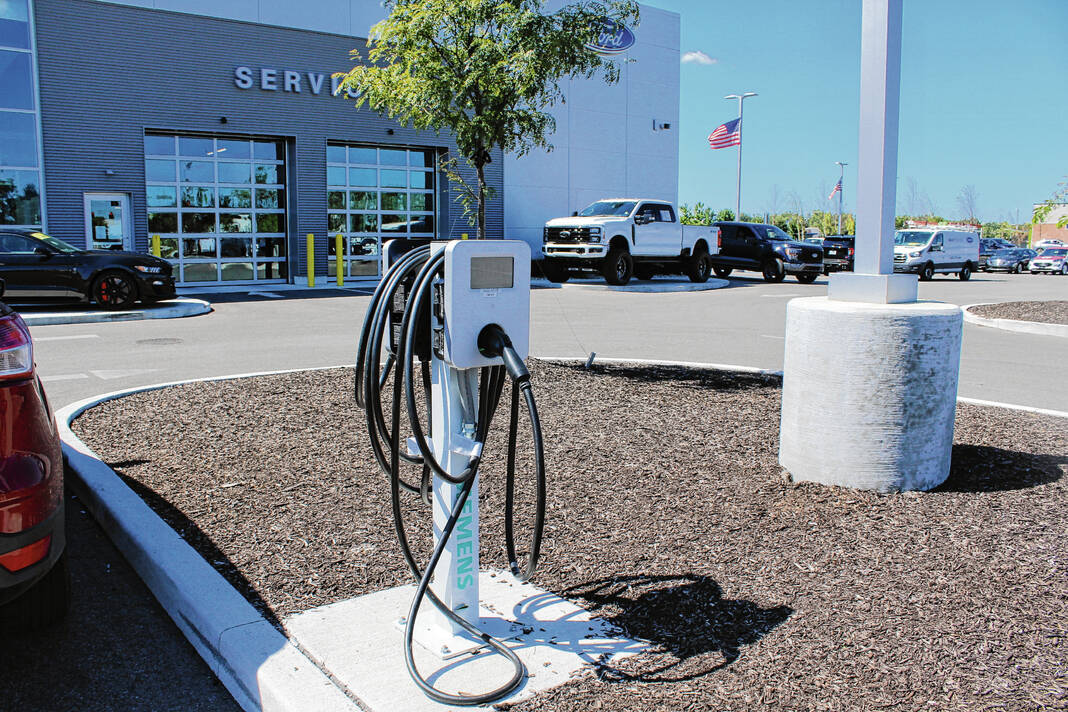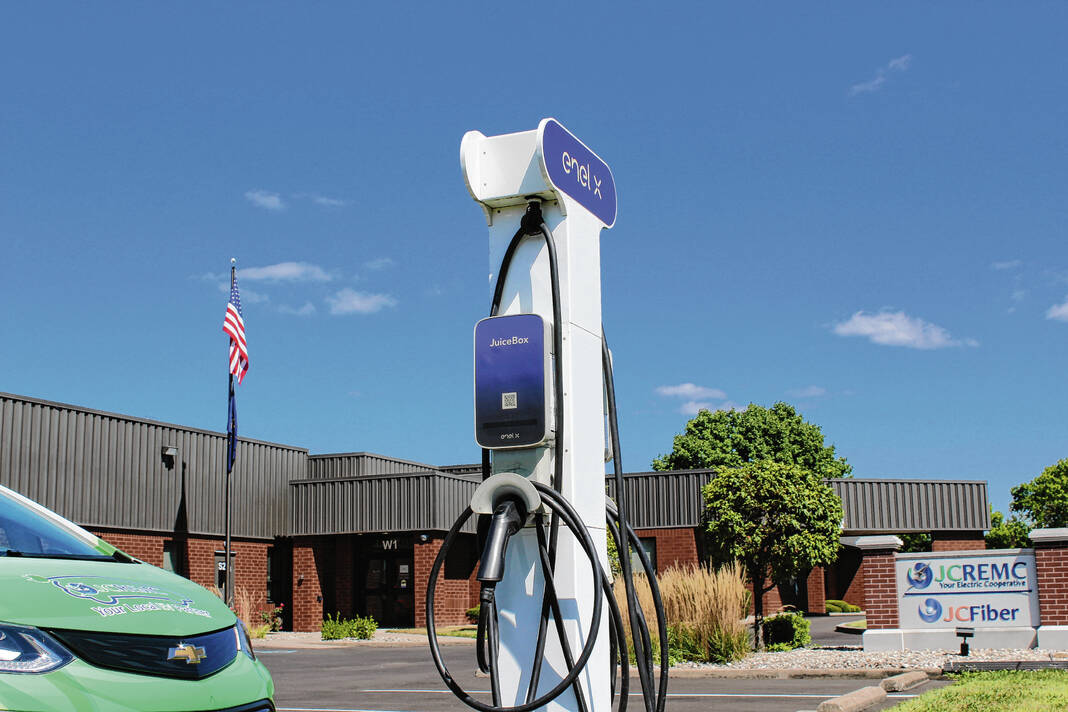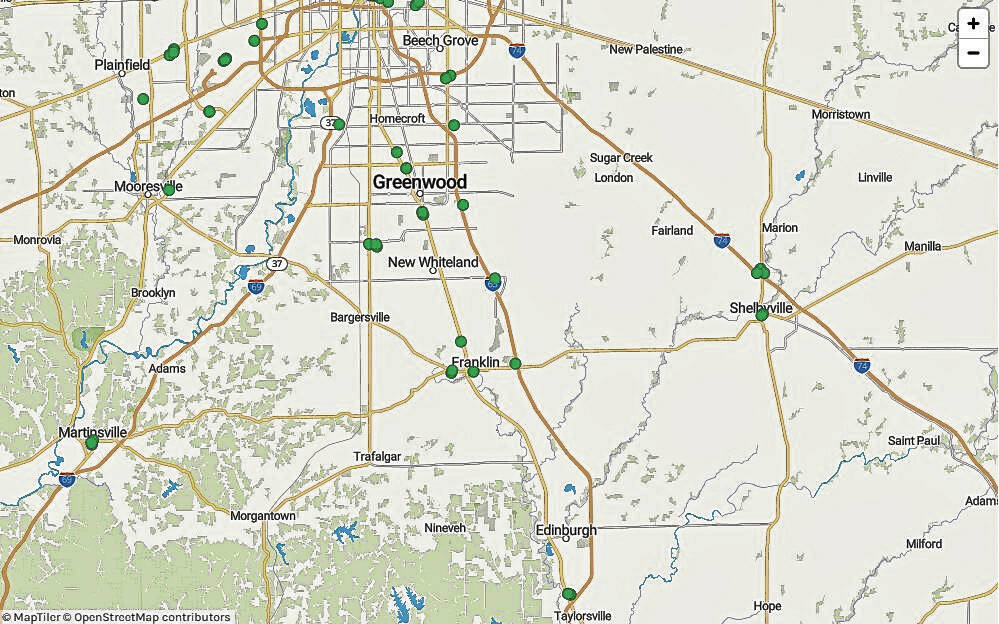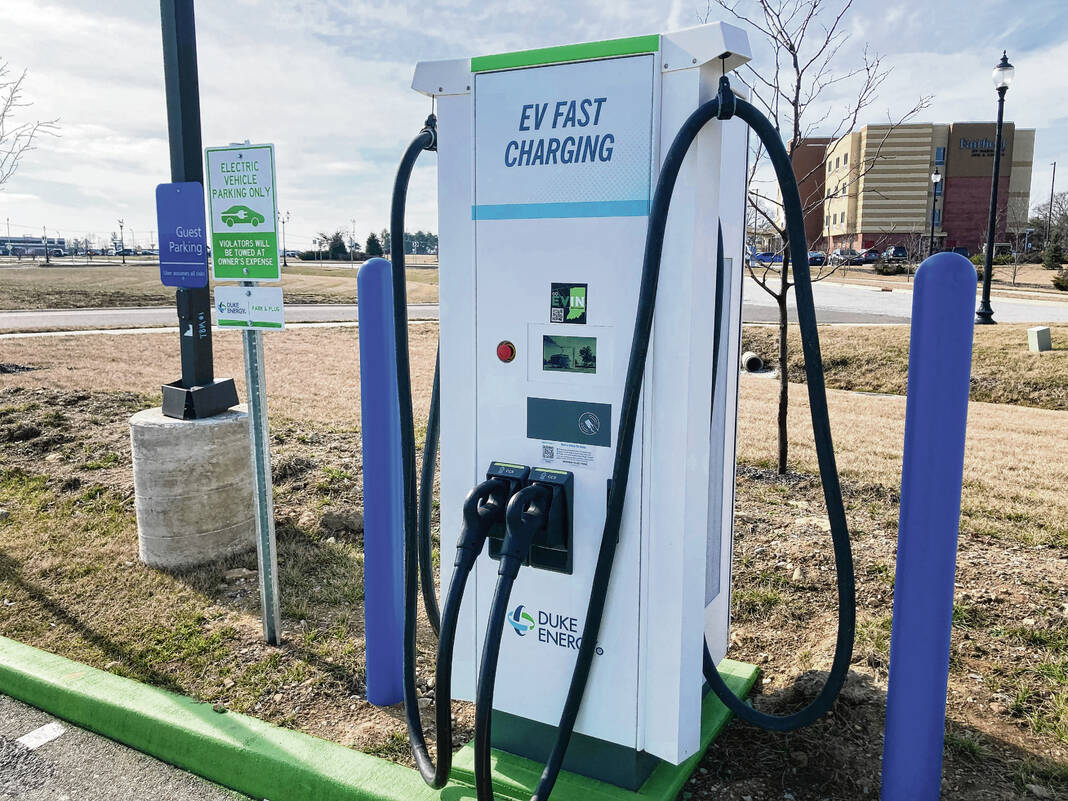Surveys suggest more people would drive electric vehicles if the charging infrastructure were more vast.
Right now, there are efforts in Johnson County and at the state level to do just that and make charging more accessible.
Across Indiana, there are at least 644 charging stations, while in Johnson County there are 21, according to the U.S. Department of Energy’s database of chargers. Among these stations, there are 1,771 charging ports in Indiana and 66 in Johnson County, the data shows.
Charging stations are analogous to gas stations, with stations being a location with multiple charging ports, and ports being like a gas pump. However, while gas pumps can typically handle two vehicles at the same time, ports can only handle one vehicle at a time even with multiple connectors.
As part of a national initiative to create a network of at least 500,000 reliable electric vehicle chargers across the U.S., the Indiana’s Department of Transportation is investing nearly $100 million through the National Electric Vehicle Infrastructure program to build a network of electric vehicle charging stations at strategic locations along Indiana’s interstates and highways, dubbed Indiana’s Alternative Fuels Corridors. The goal is to have a charger every 50 miles along the corridor as part of the federal build-out requirements, state officials have said.
On average nationally, installing a single charging station can cost anywhere from $1,000 to $2,500 as of 2022, according to the EV Charging Summit. However, costs can vary by region.
Similarly, costs for a user to charge their EV vary from state to state too. It costs an average of $0.45 per kilowatt-hour to charge an electric car at a public charging station in Indiana — the same as the national average, Axios Indianapolis reported in January.
According to a 2023 Consumer Reports survey, one-third of Americans surveyed said they would consider purchasing an EV, while seven in 10 said they would consider it eventually. Pew Research Center found in separate surveys on EVs that people surveyed are more likely to buy an EV if they see people in their area driving EVs, or if they live close to a charging station.
A Pew survey also found that people who aren’t confident in the government’s ability to create a reliable EV infrastructure were less likely to be willing to buy an EV.
According to May government data, about six in 10 Americans live within 2 miles of an EV charger, however, most infrastructure is concentrated in urban and suburban areas, with only 17% of rural Americans living within 2 miles of a charger.
As plans shape up for the EV charging network to expand, the Daily Journal reached out to stakeholders in the statewide roll-out and sought local opinions.
About INDOT’s plan
INDOT has released a draft plan for its program and plans to begin construction on charging stations in 2025. Indiana’s expansion is a part of the Biden-Harris Administration’s “Investing in America” and “Justice40” initiatives to meet the goal of net zero emissions by 2050. Through the initiative, the number of publicly-available chargers has doubled around the country since 2021.
The first round of awards for INDOT’s initiative, dubbed Charging the Crossroads, was awarded at the end of August. INDOT awarded funds to install charging stations at 39 locations across the state, including at the Thorntons gas station at 12001 N. U.S. 31, Edinburgh. The new Edinburgh charger is strategically located off Interstate 65 near Indiana Premium Outlets and several hotels.
A second round of grants is expected to be awarded earlier next year, according to INDOT.
Indiana’s plan is following the Justice40 initiative guidelines set forth by the federal government, said Natalie Garrett, strategic communications director for INDOT. The Justice40 initiative is a goal set by the federal government to provide 40% of the overall investments to “disadvantaged communities that are marginalized by under-investment and overburdened by pollution,” the initiative says.
INDOT has released a draft plan of how the department plans to follow Justice40 guidelines, which is meant to ensure charging stations are installed equitably. As part of that plan, INDOT had to identify disadvantaged communities and meet with stakeholders to develop the rollout of EV infrastructure. Public comments were accepted on the plan through July 25. The plan is still pending federal approval.
Additionally, a construction project is underway to make a stretch of roadway on U.S. Highway 231/U.S. Highway 52 in West Lafayette the first EV-charging highway. INDOT is partnering with engineers from Purdue University to test the concept of charging vehicles while they drive on a quarter-mile stretch of the road, according to the university.
Where to find local chargers
Locally, more and more chargers are popping up around Johnson County and the southside of Indianapolis. Many of the chargers are located at area hotels and car dealerships, while chargers can be found in unexpected locations such as the Johnson County REMC office, Johnson Memorial Hospital, Youngs Creek Park, Vision Quest Eyecare, JC Bank, Greenwood Park Mall and Arbonne.
However, there isn’t one map that shows all the chargers available, making it more difficult to count them. The U.S. Department of Energy’s map shows most chargers, however, mobile navigation apps such as Apple Maps and Google Maps show different chargers. Additionally, all cars don’t use the same type of charger, which means users may have to carry an adapter when traveling.
There are three “levels” of EV charging and most chargers that are publicly available are Level 2 or 3. The most ideal for travelers is Level 3, which allows fast charging, according to the U.S. Department of Energy.
Currently, more than 80% of charging electric vehicles occurs at owner’s homes, said John Sturm, Johnson County REMC’s CEO.
Sturm, who is also an EV owner, said it is important for the public chargers to be direct-current fast charging stations and be capable of charging four vehicles simultaneously.
Financial incentives
In addition to comparably higher prices to purchase some EV models over gas-powered cars, EV owners who don’t want to wait at public chargers have to make sure their home or apartment is equipped for charging. JCREMC and other electric providers such as Duke Energy are both helping build out charging infrastructure and providing incentives for EV owners to charge at home.
JCREMC offers rebates of up to $600 for the installation of a 240-voltage charging outlet to its members. JCREMC also incentivizes members to charge during their super off-peak hours, which is between 11 p.m. to 5 a.m. every day of the year. If drivers charge during the off-peak window, they can benefit from discounted rates, Sturm said.
Members can save between 25-50% on electricity costs associated with at-home charging depending on their rate and the time that they charge.
Duke Energy customers can rent a Level 2 charger for their home, paying a flat rate each month. Eligible EV drivers who charge during “off-peak hours” can earn up to $200 in annual bill credits, according to their website.
Duke Energy also offers a commercial charger rebate to places like businesses, apartment complexes and government entities to financially incentivize the installation of EV chargers for public or workplace use, said Logan Stewart, lead communications manager. For example, the Franklin’s Mayor’s Youth Leadership Council collaborated with Duke Energy to install a charger at Youngs Creek Park in May.
“The program benefits customers by offsetting costs to enter the EV market — a barrier to entry for many,” Stewart said. “Installation of EV chargers can help attract customers, showcase sustainability efforts, and encourage customers to stay longer at a place of business. In addition, the program helps Duke Energy continue to learn about the effects of EVs on the electric grid to better prepare for the future.”
Local drivers weigh in
Several readers responded to the Daily Journal’s request for information about their experiences driving an EV locally, differing on whether the existing infrastructure is good enough for long trips.
Reader John Stiles said owning a hybrid vehicle works best for him. It can operate on gas and on electricity. His car packs a maximum range of 25 miles in the winter and 33 miles in the summer before the gasoline engine kicks in. It is the perfect vehicle for him to travel to places he does frequent, he said.
Stiles said he does not think EV chargers are accessible when driving longer distances.
“If I were driving a Tesla, with a little effort I could research my route in advance and probably target a charging station before I got too dangerously close to my 300 miles of maximum range,” Stiles said. “That’s a problem, but it’s not the big problem — what am I going to do in the two hours it takes to recharge my battery? The children are hungry and need to find a restroom, the dog needs a walk, and my wife is still peeved about helping me find the charging station. And I’m still on my first leg of five or six charging stations and two days of tedious driving.”
Sturm has both an electric and gasoline engine vehicle at home. He said his Tesla is perfect for the day-to-day trips, but, for longer trips, he would stick to the traditional gasoline engine.
“I’m not taking my EV because the national or the statewide infrastructure is not there to have these fast chargers, and it’s too much of a hassle,” Sturm said.
Jennifer Webb, another reader, is more optimistic. She has owned her electric vehicle for six months and said Franklin, in particular, has “quite a few” conveniently-located stations. However, Webb said that more safety measures at charging stations would be helpful.
“It’s cheaper than gas,” Webb said. “To get a full charge, it takes about 30-35 minutes. But that gives me enough time to grab a bite to eat, nap or grab a drink. A good idea might be to install cameras at the charging stations. If it’s a late night and you’re having to charge for 30 minutes, I do feel like it leaves you vulnerable to crimes.”
Webb commutes to her job at Indiana University Bloomington from her residence in Franklin in less than one charge. While she has not taken a longer road trip since buying her EV, she feels it wouldn’t be too hard to get around with the existing infrastructure.
“If I plan a long trip into the navigation, it will plan my route with all charging places that I will need to stop at,” Webb said.
WHERE TO CHARGE
There are several ways people can find electric vehicle charging stations in the U.S., as there is not one map that shows all of the stations available. Additionally, all cars don’t use the same type of charger, which means users may have to carry an adapter when traveling.
U.S. Department of Energy
The U.S. Department of Energy’s map shows most chargers in the U.S. and Canada. The map can be found at afdc.energy.gov/stations.
Mobile navigation apps
Apps like Apple Maps and Google Maps can show different charger stations. Drivers can go to their respective websites or applications to search for stations.
Former Daily Journal intern Mia Lehmkuhl, and current staffers reporter Jayden Kennett, news editor Noah Crenshaw and editor Leeann Doerflein contributed to this report.













